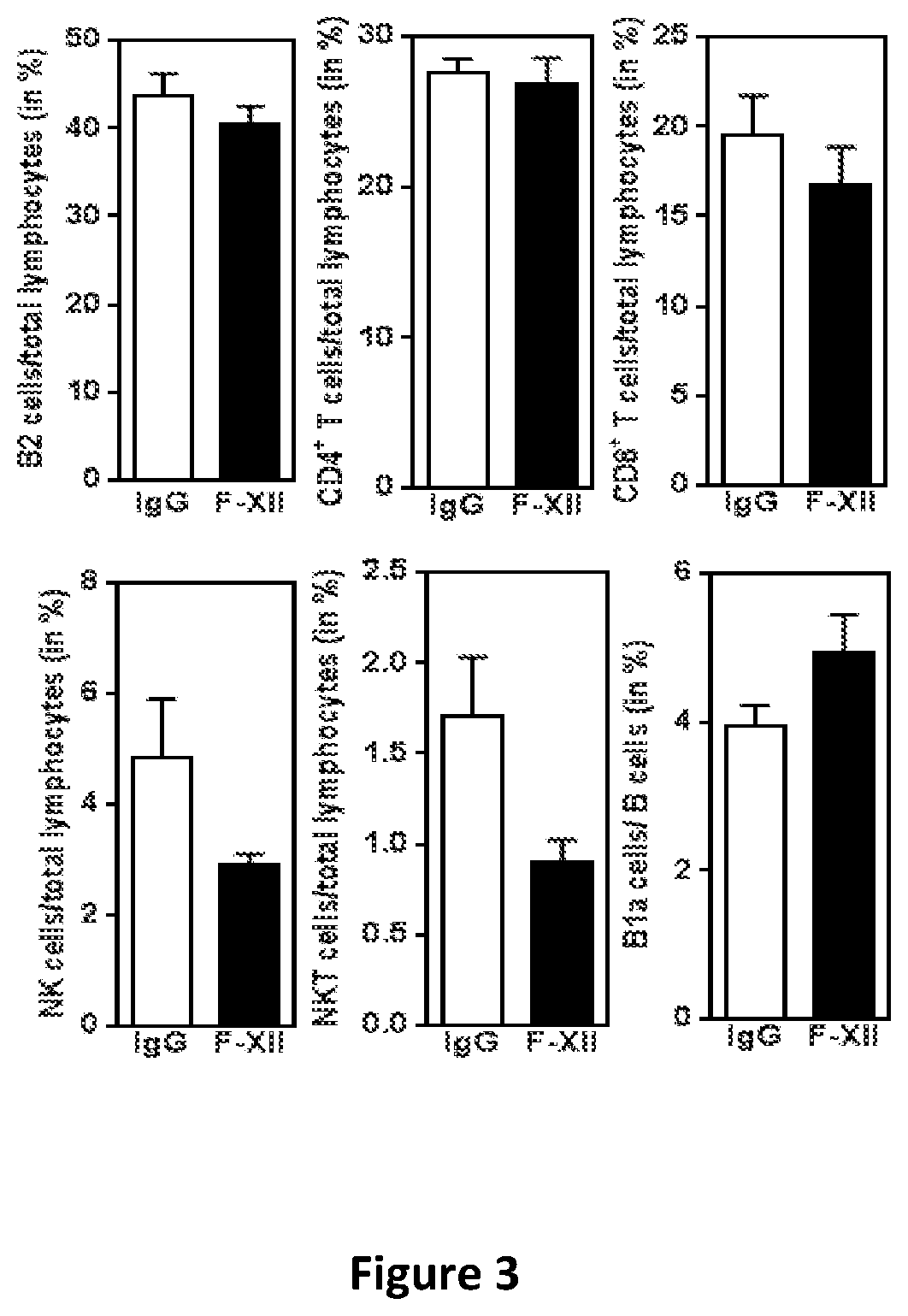Method of treating atherosclerosis
a technology of atherosclerosis and atherosclerosis cells, applied in the field of atherosclerosis treatment or prevention, can solve the problems of low-grade chronic inflammation, high economic burden for health care systems, and correlation with risk of atherosclerotic complications, and achieve the effects of stabilizing unstable atherosclerotic plaques, reducing lesion size, and slowing the progression of atherosclerosis
- Summary
- Abstract
- Description
- Claims
- Application Information
AI Technical Summary
Benefits of technology
Problems solved by technology
Method used
Image
Examples
example 2
I Inhibitor Treatment Reduces Arterial Inflammation and Increases Smooth Muscle Cell Number in Atherosclerotic Plaques
[0523]To determine whether FXII inhibitor treatment reduced inflammation as a driving force of plaque development, the effect of chronic FXII inhibitor (3F7) treatment on the expression of vascular cell adhesion molecule-1 (VCAM-1; clone sc-1504, Santa Cruz) was investigated in atherosclerotic lesions of the aortic root and the aortic arch. A reduction of VCAM-1 expression was observed in the atherosclerotic lesions of the aortic root (43%) and the aortic arch (33%) (all P<0.05; FIG. 4A, B).
[0524]H&E staining also revealed a significant reduction in the size of the acellular area (necrotic core) in the atherosclerotic lesions of the aortic root and the aortic arch 33% and 50%, respectively, in 3F7 treated mice compared to the istotype IgG monoclonal antibody treated control group (all P<0.05; FIG. 4C, D).
[0525]In addition, we assessed the effect of FXII inhibitor tre...
example 3
ment Achieves Plaque Stabilization
[0527]To specifically address the question whether 3F7 has the potential to stabilize plaques, a recently developed unique mouse model of plaque instability / rupture was used.
[0528]In this model male ApoE− / − (ApoE-KO) mice were fed a high fat diet for 6 weeks to develop established atherosclerosis. At 12 weeks of age, 6 weeks after commencement of the high fat diet, ApoE-KO mice were anaesthetized by a ketamine (100 mg / kg) and xylazine (10 mg / kg) mixture through intraperitoneal injection. An incision was made in the neck and the right common carotid artery was dissected from circumferential connective tissues. A tandem stenosis with 150 μm (or 450 μm) outer diameters was introduced with the distal point 1 mm from the carotid artery bifurcation and the proximal point 3 mm from the distal stenosis. The stenosis diameter was obtained by placing a 6-0 blue braided polyester fibre suture around the carotid artery together with a 150- or 450-μm needle that...
example 4
file of Treated Animals
[0530]Cholesterol profiles (total cholesterol, high-density lipoprotein cholesterol, very-low-density lipoprotein / LDL cholesterol, and triglycerides) in plasma from ApoE− / − (ApoE-KO) mice either treated with 3F7 or control antibody were measured as described below.
Cholesterol
[0531]Cholesterol levels were measured by a standard commercial enzymatic assay using a Beckman Coulter LX20PRO Analyzer, with reagents and calibrators supplied by Beckman Coulter Diagnostics Australia.
[0532]CHOL reagent is used to measure cholesterol concentration by a timed-endpoint method. In the reaction, cholesterol esterase (CE) hydrolyzes cholesterol esters to free cholesterol and fatty acids. Free cholesterol is oxidized to cholestene-3-one and hydrogen peroxide by cholesterol oxidase (CO). Peroxidase catalyzes the reaction of hydrogen peroxide with 4-aminoantipyrine (4-AAP) and phenol to produce a colored quinoneimine product.
[0533]The SYNCHRON LX® System(s) automatically proporti...
PUM
| Property | Measurement | Unit |
|---|---|---|
| density | aaaaa | aaaaa |
| density | aaaaa | aaaaa |
| equilibrium dissociation constant | aaaaa | aaaaa |
Abstract
Description
Claims
Application Information
 Login to View More
Login to View More - R&D
- Intellectual Property
- Life Sciences
- Materials
- Tech Scout
- Unparalleled Data Quality
- Higher Quality Content
- 60% Fewer Hallucinations
Browse by: Latest US Patents, China's latest patents, Technical Efficacy Thesaurus, Application Domain, Technology Topic, Popular Technical Reports.
© 2025 PatSnap. All rights reserved.Legal|Privacy policy|Modern Slavery Act Transparency Statement|Sitemap|About US| Contact US: help@patsnap.com



